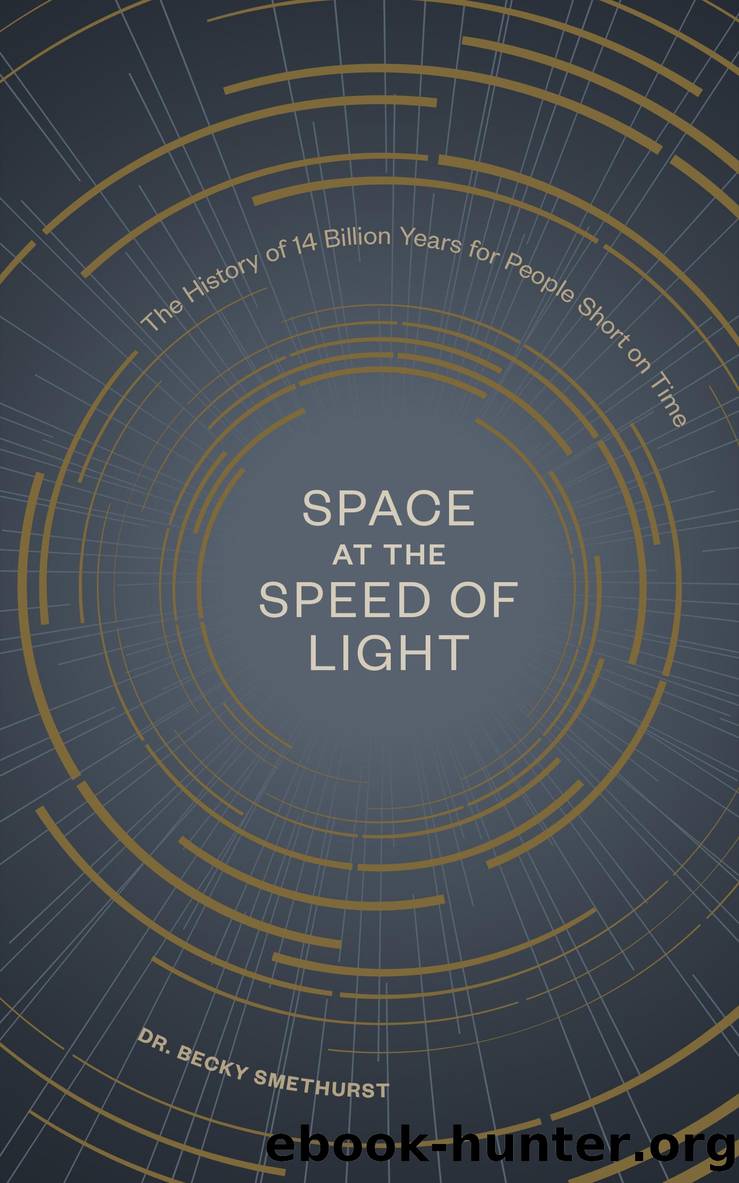Space at the Speed of Light by Dr. Becky Smethurst

Author:Dr. Becky Smethurst [Smethurst, Becky]
Language: eng
Format: epub
Publisher: Potter/Ten Speed/Harmony/Rodale
Published: 2020-06-02T00:00:00+00:00
The universe sprang into being, in a wondrous storm of creation, 14 billion years ago; 9.5 billion years later, the Sun, the Earth, and the solar system started to take shape. After another billion years, life developed in the Earth’s oceans, paving the way for dinosaurs to walk the land (a mere 13.5 billion years since the big bang). Fast-forward through the next 500 million years, with the evolution of plants, mammals, and birds, through the rise and fall of the Greek, Roman, and Mayan civilizations, until we arrive in 1995. The Spice Girls are at the top of their game, Toy Story has just come out in the cinema, and—finally—the first confirmed planet around another star in the Milky Way is found. The discovery of this planet, dubbed the very lyrical sounding 51 Pegasi b, is, for me, one of the greatest astronomical discoveries to occur in my lifetime.1
This discovery confirmed that our solar system was not merely an oddity in the universe—that other stars also had planets orbiting them and that maybe, just maybe, those planets might host life.
Furthermore, it kicked off what has been referred to as the “golden age” of exoplanet research, where discovering a new planet has become the norm for a Tuesday afternoon. It’s something any keen amateur astronomer could get involved with if they wanted. But the real question, even before that first confirmed discovery in 1995, has always been, where is the most Earth-like planet? We want to know if there are other planets out there like ours, orbiting stars like ours, and possibly hosting life like ours. In recent years this quest has shifted from mere curiosity to one that feels as if it’s driven by necessity, even though—as discussed in the previous chapter—moving to another Earth is unlikely to be a viable option for us, no matter how much we might end up needing one.
The impending doom of our own planet aside, how do we go about finding an extrasolar planet? There are three main methods people use to find these exoplanets: direct imaging, radial velocity measurements, and stellar transits. The first, direct imaging, does exactly what it says on the tin. You take a direct image of the planet orbiting around its star. While this might sound easy, remember, stars shine and give out a rather large amount of energy in order for us to be able to see them so many millions of miles away. Planets, however, do not shine; they merely reflect the light from their stars so we can see them. This is how we see the Moon and planets in the solar system. Of course, that means that the star is significantly brighter than the planet when you try to take an image, and this makes the planet incredibly difficult to spot—like trying to see someone holding an LED next to the glare of a stadium floodlight.
The trick to this method’s success is, first, to block the light from the star, essentially by placing a circular mask over the middle of your telescope detector, and then take an image.
Download
This site does not store any files on its server. We only index and link to content provided by other sites. Please contact the content providers to delete copyright contents if any and email us, we'll remove relevant links or contents immediately.
| Aeronautics & Astronautics | Astronomy |
| Astrophysics & Space Science | Comets, Meteors & Asteroids |
| Cosmology | Mars |
| Solar System | Star-Gazing |
| Telescopes | UFOs |
Tools of Titans by Timothy Ferriss(8303)
Turbulence by E. J. Noyes(7977)
Secrets of Antigravity Propulsion: Tesla, UFOs, and Classified Aerospace Technology by Ph.D. Paul A. Laviolette(5330)
Astrophysics for People in a Hurry by Neil DeGrasse Tyson(5151)
Room 212 by Kate Stewart(5068)
Design of Trajectory Optimization Approach for Space Maneuver Vehicle Skip Entry Problems by Runqi Chai & Al Savvaris & Antonios Tsourdos & Senchun Chai(5037)
Pale Blue Dot by Carl Sagan(4950)
The David Icke Guide to the Global Conspiracy (and how to end it) by David Icke(4654)
A Journey Through Divination and Astronomy by Publishing Pottermore(4363)
Goodbye Paradise(3761)
Apollo 8 by Jeffrey Kluger(3664)
COSMOS by Carl Sagan(3585)
Losing the Nobel Prize by Brian Keating(3518)
The Five People You Meet in Heaven by Mitch Albom(3515)
How to Read Water: Clues and Patterns from Puddles to the Sea (Natural Navigation) by Tristan Gooley(3430)
Brief Answers to the Big Questions by Stephen Hawking(3392)
How to Read Nature by Tristan Gooley(3290)
The Order of Time by Carlo Rovelli(3162)
A Brief History of Time by Stephen Hawking(2991)
